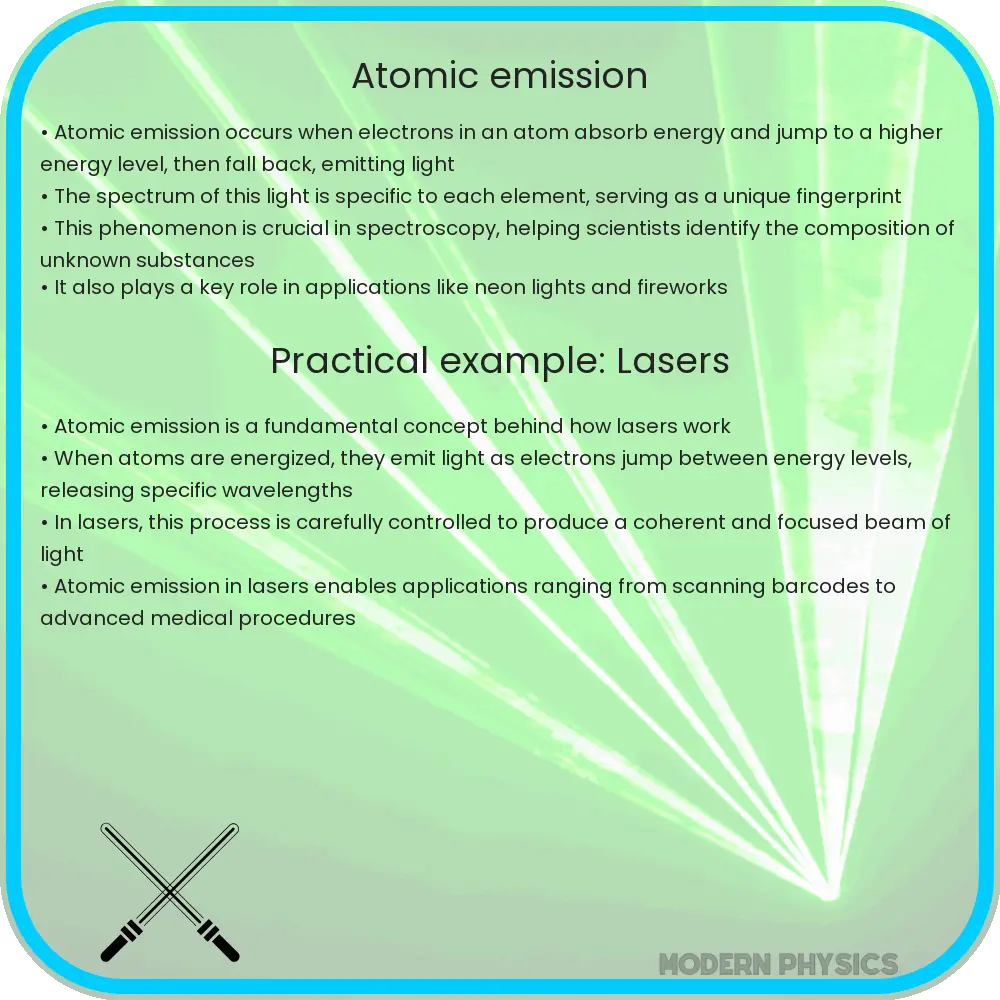Atomic emission is the process where atoms release energy as light when electrons transition between energy levels, fundamental in applications like spectroscopy and lighting.

Understanding Atomic Emission
Atomic emission is a fundamental concept in physics that explains how atoms release energy in the form of light. This phenomenon is not just a cornerstone in theoretical physics but also has multiple practical applications ranging from analyzing stars to designing energy-efficient lighting sources. To fully appreciate atomic emission, it’s essential to start with the basic structure of an atom and proceed to how these emissions form a spectrum.
Basics of Atomic Structure
Atoms consist of a nucleus made up of protons and neutrons, surrounded by electrons orbiting in different energy levels. Electrons in an atom can move between these levels by either absorbing energy to jump to a higher level or releasing energy to fall back to a lower level. This energy is often released in the form of electromagnetic radiation, which includes visible light.
How Atomic Emission Occurs
Atomic emission occurs when an electron in a higher energy state in an atom returns to a lower energy state, releasing a photon of light in the process. The energy of the emitted photon corresponds to the difference in energy between the two states. This relationship is described by the equation:
E = h * ν
Where E is the energy of the photon, h is Planck’s constant (6.62607015 × 10-34 m2 kg / s), and ν (nu) is the frequency of the photon. Since the energy levels of electrons in an atom are fixed (quantized), the emitted light always has specific frequencies.
The Atomic Emission Spectrum
The set of frequencies of the electromagnetic waves emitted by atoms of an element is known as its emission spectrum. Because each element has a unique electron configuration, each one has a unique emission spectrum. This spectrum can be seen as series of discrete lines usually referred to as a line spectrum. Each line in the emission spectrum corresponds to a specific electronic transition between energy levels in an atom.
An easy way to visualize atomic emission spectra is to think about the light emitted by neon lights or fireworks. Each color seen in these displays is a direct result of atomic emissions from different elements or compounds.
Applications of Atomic Emission
- Spectroscopy: One of the primary tools in analytical chemistry, spectroscopy utilizes the principle of atomic emission to identify the composition and properties of substances.
- Astronomy: Astronomers analyze the light emitted by distant stars and galaxies to determine their composition, temperature, density, and motion. This analysis is mainly based on studying their emission spectra.
- Lighting: Understanding atomic emissions is crucial in designing energy-efficient lighting systems, such as LEDs, that utilize specific elements to produce desired colors.
Challenges in Studying Atomic Emission
While atomic emission provides invaluable insights, there are several challenges scientists face when studying these phenomena. High precision instruments are required to measure the frequency and intensity of emitted light accurately. Environmental factors such as temperature, pressure, and surrounding medium can also affect emission spectra, requiring careful control and calibration of experimental conditions.
Recent Advances in Atomic Emission Research
Recent technological advancements have significantly improved the accuracy and efficiency of spectroscopic analysis. For example, the development of laser-induced breakdown spectroscopy (LIBS) has allowed for more rapid and precise analysis of materials in a variety of conditions, ranging from industrial processing to Martian soil analysis by rovers. Additionally, quantum computing and AI are beginning to find applications in predicting and analyzing complex emission spectra, opening new avenues for research and practical applications.
Environmental Impact and Sustainability Considerations
The study and application of atomic emission is not only a scientific endeavor but also has environmental and sustainability implications. For instance, enhancing the efficiency of LEDs helps reduce electricity consumption and greenhouse gas emissions. Moreover, spectroscopy can be used to detect pollutants in water and air, contributing to environmental monitoring and protection strategies.
Conclusion
Atomic emission is a multifaceted subject that holds the key to understanding not only fundamental physical processes but also various practical applications across different fields. From helping astronomers peek into the celestial origins to enabling chemists to ascertain the composition of unknown substances, atomic emission stands as a pillar of modern scientific inquiry. Despite its challenges, continued advancements in technology are making it possible to overcome obstacles and unlock even deeper insights. Atomic emission, therefore, not only enlightens us about the nature of matter at a microscopic level but also helps us harness this knowledge for technological and environmental benefits. This ongoing exploration of atomic emission is a vivid example of how fundamental science is intimately linked to everyday technological advancements and environmental stewardship, reflecting a harmonious blend of curiosity and practicality.
